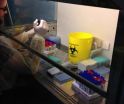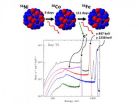(Press-News.org) In almost 20 years, China's R&D expenditure as a percentage of its gross domestic product has more than tripled, reaching 1.98 per cent in 2012. This figure surpasses the 28 member states of the EU, which collectively managed 1.96 per cent.
However, despite this, China saw a sharp decline in money spent on scientific research, in particular applied research. Basic research funding plummeted from 5.2 per cent in 1995 to 4.7 per cent in 2011, and applied research funding fell from 26.4 per cent to 11.8 per cent in the same years.
This is Dr Cao's second Science article in a year. Last August, he led a group of scholars from the US and China to publish an article on the reform of China's science and technology (S&T) system.
This article, in collaboration with Dr Yutao Sun, from the Dalian University of Technology in China, acknowledges a recent move by the Chinese government to increase transparency of its R&D expenditure, details of which have benefited the research.
Dr Sun and Dr Cao of the School of Contemporary Chinese Studies said: "China's recent requirement that central government agencies release their departmental annual reports indicates that the nation is catching up to international norms in disclosing the government's expenditure, including its R&D expenditure profile, emphasising not only aggregate statistics but also the structure of, and government's contribution to, the expenditure."
A need for further reforms
Although recent reforms have decentralised distribution of China's R&D spending, through a series of agencies, which the authors acknowledge could be advantageous, they also present new challenges, including a lack of top-level design, effective coordination, and transparency in budgeting and spending. This has led to a both an overlap between agencies or even a rush to spend funds in certain programmes.
While the improved transparency goes some way to bringing China's R&D reporting processes in line with international norms, the authors criticise the fact that the Chinese government embeds its R&D expenditure in its broader S&T expenditure statistics. Instead, they argue, China's government should switch its reporting from S&T to R&D expenditure, as well as ensuring the government's R&D expenditure is cited in the country's R&D statistics.
"It is a key step to bringing transparency to government R&D funding and helping reduce corruption, as well as harmonising with international norms," explained Dr Sun and Dr Cao.
A missing link?
The authors believe the shift from spending on predominantly applied research to development research may be attributed to China's innovation policy, which favours development over scientific research.
Dr Cao said: "The low share of scientific research expenditure has negatively affected China's innovation capability and may jeopardise China's ambition to become an innovation-oriented nation. Shrinking of applied research is a serious problem, because applied research links basic and development research."
The authors recommend that, ultimately, if China wants its research and development to compete on a world stage, its government needs to increase its contribution from 21.7 per cent in 2011 of gross expenditure in R&D to 30 per cent by 2020, bringing it in line with competing nations.
INFORMATION:
The research was supported by a Marie Curie fellowship from the EU's Seventh Framework Programme.
Link to the paper: http://www.sciencemag.org/content/345/6200/1006.full?sid=8024430a-7c6e-408a-9b01-820997b15a64
China's reform of R&D budget management doesn't go far enough
2014-08-29
ELSE PRESS RELEASES FROM THIS DATE:
Snails tell of the rise and fall of the Tibetan Plateau
2014-08-29
Boulder, Colo., USA - The rise of the Tibetan plateau -- the largest topographic anomaly above sea level on Earth -- is important for both its profound effect on climate and its reflection of continental dynamics. In this study published in GSA Bulletin, Katharine Huntington and colleagues employ a cutting-edge geochemical tool -- "clumped" isotope thermometry -- using modern and fossil snail shells to investigate the uplift history of the Zhada basin in southwestern Tibet.
Views range widely on the timing of surface uplift of the Tibetan Plateau to its current high ...
Science advice to governments comes of age at Auckland conference
2014-08-29
Auckland, New Zealand (29 August) — Science advice to governments has emerged as a discipline in its own right, which is both art and science. This is what delegates to the world's first summit of science advice heard at a meeting in Auckland, which closed today with a strong call to strengthen international collaboration, an agreement to formalise the network and meet again in 2016.
Convened by the International Council for Science (ICSU) and hosted by New Zealand's Chief Science Advisor, Sir Peter Gluckman, this historic summit marks a turning point in the global awareness ...
Intervention needed for survivors of childhood burns
2014-08-29
Adults who have been hospitalized for a burn as a child experience higher than usual rates of depression and suicidal thoughts, according to new research at the University of Adelaide.
A 30-year follow up of childhood burns victims has been conducted by the University's Centre for Traumatic Stress Studies. They found that 42% of people surveyed had suffered some form of mental illness and 30% suffered depression at some stage in their lives.
The results, now published in the journal Burns, also found that long-term depression was an issue among the group, and 11% had ...
Can YouTube save your life?
2014-08-29
Only a handful of CPR and basic life support (BLS) videos available on YouTube provide instructions which are consistent with recent health guidelines, according to a new study published in Emergency Medicine Australasia, the journal for the Australasian College for Emergency Medicine (ACEM).
Early recognition and treatment of sudden cardiac arrest are known to improve survival for
victims.
A team of Turkish emergency medicine specialists put together the study, which reviewed educational videos from the last three years accessed via YouTube when the search terms ...
Rapamycin or FK506, which is better for SCs migration and peripheral nerve repair
2014-08-29
FK506 possesses a well-studied neuroregenerative effect, stimulating neurite extension in the presence of nerve growth factor in vitro, and enhancing nerve regeneration following nerve crush injury and isografting. However, the use of FK506 to stimulate nerve regeneration is limited because of the risk of renal failure and hypertension, and its considerable cost. With long-term allografts, FK506 alone or combined with other drugs reportedly cause life-threatening infections. Like FK506, rapamycin is an immunosuppressant and FKBP-12-binding ligand, and has a neuroregenerative ...
MERS: Low transmissibility, dangerous illness
2014-08-29
The MERS coronavirus has caused disease outbreaks across the Arabian Peninsula and spread to Europe several times. The severe pneumonia virus has claimed the lives of several hundred people since its discovery in 2012. For a long time, scientists have been puzzled over how easily the pathogen spreads from human to human. An international team of researchers led by virologists from the University of Bonn have now come to the conclusion, through direct observation, that the rate of human transmission is low. Still, a third of infected persons with symptoms die. The results ...
Astrophysicists report radioactive cobalt in supernova explosion
2014-08-29
A group of astrophysicists, including researchers from MIPT, have detected the formation of radioactive cobalt during a supernova explosion, lending credence to a corresponding theory of supernova explosions. Details are given in the journal Nature, one of the most cited scientific publications in the world.
The article's main author, Yevgeny Churazov (Space Research Institute of the Russian Academy of Sciences), together with his co-authors, including Sergei Sazonov of the Space Research Institute and MIPT, reported the results of their analysis of data collected with ...
Cellphone addiction 'an increasingly realistic possibility,' Baylor study finds
2014-08-29
Women college students spend an average of 10 hours a day on their cellphones and men college students spend nearly eight, with excessive use posing potential risks for academic performance, according to a Baylor University study on cellphone activity published in the Journal of Behavioral Addictions.
"That's astounding," said researcher James Roberts, Ph.D., The Ben H. Williams Professor of Marketing in Baylor's Hankamer School of Business. "As cellphone functions increase, addictions to this seemingly indispensable piece of technology become an increasingly realistic ...
'K-to-M' histone mutations: How repressing the repressors may drive tissue-specific cancers
2014-08-29
Kansas City, MO. - In a cell's nucleus, chromosomal DNA is tightly bound to structural proteins known as histones, an amalgam biologists call chromatin. Until about two decades ago, histones were regarded as a nuclear "sidekick," the mere packing material around which the glamorous DNA strands were wrapped. Recently, however, biologists have developed a greater appreciation for how DNA/histone interactions govern gene expression.
In 2012, investigators from multiple research institutions studying the sequence of the genome from cancer patients rocked the "chromatin world" ...
Copper shines as flexible conductor
2014-08-29
Bend them, stretch them, twist them, fold them: modern materials that are light, flexible and highly conductive have extraordinary technological potential, whether as artificial skin or electronic paper.
Making such concepts affordable enough for general use remains a challenge but a new way of working with copper nanowires and a PVA "nano glue" could be a game-changer.
Previous success in the field of ultra-lightweight "aerogel monoliths" has largely relied on the use of precious gold and silver nanowires.
By turning instead to copper, both abundant and cheap, ...




